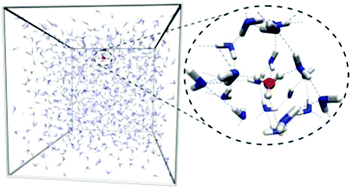Towards a dissociative SPC-like water model II. The impact of Lennard-Jones and Buckingham non-coulombic forces
Abstract
The dissociative water model developed by Garofalini and coworkers provides a versatile and effective approach to model proton transfer in a liquid water environment. This work presents the continuation of a previous study aiming at improving the transferability of this model, thereby enabling its application via third party simulation programs. In particular it is probed, whether a re-formulation of the non-coulombic interaction potential in the framework of the more common Lennard-Jones (LJ) and Buckingham formulation is feasible. In order to minimise the deviation of the structural properties between the original and modified models, while at the same time the rovibrational spectrum and proton transfer characteristics are optimised to best match experimental data, a hierarchical optimisation strategy is applied to adjust the parameters of the associated three-body interaction potential. While the application of the Lennard-Jones potential resulted in a slight overstructuring of the liquid typical for LJ-based simple-point charge models, the Buckingham formulation provides a virtually unmodified description of the liquid structure, while the overall proton diffusion coefficient of 0.96 Å2 ps−1 and the average proton-donor lifetime of 1.39 ps are found in good agreement with the respective reference values of 0.93 Å2 ps−1 and 1.24 to 1.70 ps obtained via experiment and Car–Parrinello molecular dynamics simulations, respectively. Comparison of the pair distribution functions and the vibrational spectra with their experimental counterpart highlight that the proposed potential model provides a state-of-the-art description of liquid water in addition to the comparably rare capability of adequately describing proton transfer events in aqueous solution. Due to the widespread use of the Lennard-Jones and Buckingham non-coulombic potentials in simulations relevant for life and material sciences, the re-formulated dissociative water potentials can be combined with established force-field models in a straight-forward way.

- This article is part of the themed collection: 2018 PCCP HOT Articles


 Please wait while we load your content...
Please wait while we load your content...